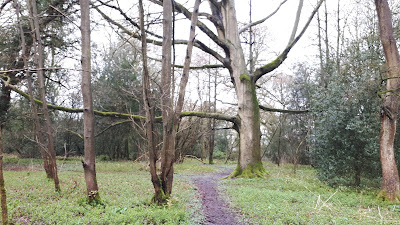A call alerted these Black-tailed Godwits, which were sleeping a moment before, they raised their heads, watching attentively. A few Ruff were also present.
Tuesday 25 February 2020
At Blacktoft Sands
A call alerted these Black-tailed Godwits, which were sleeping a moment before, they raised their heads, watching attentively. A few Ruff were also present.
Monday 24 February 2020
A walk around Burton Bushes and Beverley Westwood
Andrew Chadwick at Hull Nats told me he'd seen a Nuthatch at Burton Bushes last week. This species is a rarity in East Yorkshire and I had never seen one there and very rarely in the surroundings of Hull (I had one at Pearson Park on the 22/7/2013), so today, after lunch I drove to the Westwood to have a look. It was breezy but quite mild, and it had been raining all morning.
I have blogged about Burton Bushes before, a small patch of ancient woodland, with large oaks, holly and birch. The mosses in the wood were at their best. Wood Anemone leaves and buds were out, and the leaves of Bluebells and Dog's Mercury.
There were many Blue and Great Tits about, a single Coal Tit, Robins singing. I was very pleased to find the woodland empty of people, as the place is very popular with dog walkers. I guess the mud must be keeping them away. I'm glad I wore my wellies, as the wood was very wet and the paths muddy. With the place to myself, I walked slowly around the wood, listening to the birds, backtracking to check calls, taking everything in. As I got to the easternmost side, I heard a Nuthatch call and saw one right away, then another in a tree nearby. They fed on the trunk of the trees, and one moved to the ground before both flew away away. I took some photos but didn't follow them, I'm hoping they are a pair and they establish themselves in the wood.
After the circuit around the wood I walked along the eastern side of the Westwood, following the perimeter hedgerow. A female Bullfinch fed on hawthorn buds. Fifteen Blackbirds, a Song Thrush and a Redwing enjoyed the worms.
After crossing the Walkington road I heard a Marsh Tit. I located it and got a few record shots. Further along a Skylark landed on the short grass of one of the golf course runs - also free of golfing today - and sat against the wind. Later two were singing over the long grass. On the lee side of the wind, two Goldcrests sallied to and fro from a low hawthorn catching midges. A flock of Starlings fed on the grass.
Friday 21 February 2020
February floods at Pearson Park
Despite the chaos I've been surprised by how the birds have really taking it on their stride. The pools formed by the rain actually have offered them a safe haven from dogs and people. Geese are spending a lot of time by the pools, and have abandoned the pond. Gulls have also relocated there, and have been enjoying the worm bonanza. There has been a regular Grey Wagtail about in the last week and even a Pied Wagtail which is a rarity in the park. Black-headed Gulls, which are rare in the park, are feeding amongst the common gulls, particularly enjoying the pools.
This is just a selection of some of the birds I've been photographing in the park during February.


























































